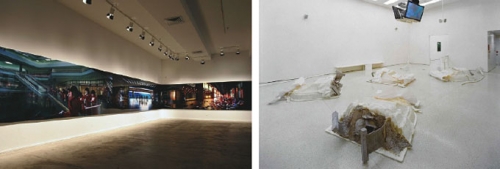Art Works! The world’s largest corporate collection
Assembling over 50,000 works and displaying them in its offices rather than shutting them away to gather dust in a vault somewhere: this is how the world’s largest corporate art benefactor shows its commitment to art and artists. From at home to its overseas locations, and now to exhibitions and art fairs: what is the goal of this massive corporate player so keen to expand its involvement in art?
Research/text: ART iT
As three of the art world’s biggest events – the Venice Biennale, Münster Sculpture Project, and Documenta (Kassel) – coincide this year for the first time in a decade, German art is very much in the spotlight. At Venice it has been Isa Genzken’s solo show Oil at the German Pavilion. At Münster, it is probably Genzken again, with her sculpture exhibit. At Kassel, the Deutsche Bank Art Lounge. All are sponsored by Deutsche Bank, one of Germany’s “big three” financial institutions.
Pioneering and ambitious program
Deutsche Bank began collecting art seriously in 1979. The main focus initially was on contemporary artists born after the war, in particular works on paper such as drawings and photographs, in accordance with the motto ‘Art at Work’. Art at work in a figurative sense as well of course, as in art working, but first and foremost, quite literally, ‘art in the workplace’. Most of this huge collection now numbering over 50,000 items, making it the world’s largest owned by any single company, is actually on display in the bank’s approximately 1000 offices around the world.
According to Friedhelm Hütte, who along with Director Ariane Grigoteit, runs the company’s global art operations, “Works on paper dominate the collection, and for the time being I imagine that ratio will not change: for a number of simple reasons. First, our premises don’t have huge spaces, so there is nowhere to put large works of art. Secondly, unlike paintings and sculptures, works on paper can be easily preserved using just a frame and glass. Thirdly, drawings being the first visible results of new concepts and can act as inspiration for new programs and ideas. And finally, we don’t want to be competing with art museums and galleries, who tend to focus more on paintings and sculptures.” The directors of Deutsche Bank Art have built networks in countries around the world, and never miss a chance to gather information on works the company should add to its collection, and artists it ought to support.
“Deutsche Bank is a global enterprise. As our overseas branches have expanded, so has the scope of our art operations. These days we commission works, organize and sponsor exhibitions, and support art fairs such as Frieze in London.”
Thus the bank displays items from its collection not only in its own offices, but also as temporary loans or exhibitions in art museums and galleries in Germany and elsewhere. In 1997 it joined with the Guggenheim Foundation to open the Deutsche Guggenheim in Berlin. It also stages three or four solo shows annually featuring outstanding contemporary artists that have included the likes of Sugimoto Hiroshi, Yanagi Miwa, Nam June Paik, and Cai Guo-Qiang. Yanagi’s show is currently at New York’s Chelsea Museum of Art (through 8.25), and in September, the bank will sponsor a Richard Prince retrospective also in New York, at the Guggenheim.
The Joseph Beuys connection
In Venice, the show All in the Present Must Be Transformed: Matthew Barney and Joseph Beuys is currently on at the Peggy Guggenheim Collection. The exhibition is touring from Berlin, but in fact it seems Beuys, the father of contemporary art, and Deutsche Bank have been closely connected since the early days of the bank’s collection.
Hermann J. Abs and Herbert Zapp, Deutsche Bank CEO and board member in the 1970s, were associates of Beuys. Zapp, who was driver of the Art at Work project, added works by Beuys to the collection, and grew to be on intimate terms with the charismatic artist, to an extent that allowed him to engage in some fairly frank ribbing. Beuys, a political activist deeply involved in various social movements, is said to have cheekily referred to Zapp as the ‘old capitalist’, an anecdote that can be found on none other than the Deutsche Bank website, along with the comment that “their relationship was characterised by both humour and mutual respect.”
Hütte continues:
“Investment is not our objective. Obviously we are aware that we play a part in the bank’s marketing and customer service operations. In contemporary art one often needs to explain what is behind each piece, for one thing, which is precisely why we get so much inspiration from communicating with employees and clients. We are proud to be involved in the community through culture. “
Beuys believed that society as a whole should be regarded as one great work of art: would it be flattering Deutsche Bank to say that to some degree at least, it has helped to keep Beuys’ philosophy alive today?

Left: Miwa Yanagi: Deutsche Bank Collection at the Chelsea Art Museum
Right: Matthew Barney Chrysler Imperial 2002 (detail) at All in the Present Must Be Transformed: Matthew Barney and Joseph Beuys, Deutsche Guggenheim
Photo David Heald, courtesy Solomon R. Guggenheim Foundation, NY
Deutsche Bank Collection
http://www.deutsche-bank-art.com
Deutsche Guggenheim
Unter den Linden 13/15, 10117 Berlin
+49(0)30-2020930
http://www.deutsche-guggenheim.de
db-artmag (online art magazine)
http://www.db-artmag.com
Peggy Guggenheim Collection
http://www.guggenheim-venice.it
Guggenheim Museum New York
http://www.www.guggenheim.org
[This article appears also in ART iT No. 16 Summer/Fall 2007]
